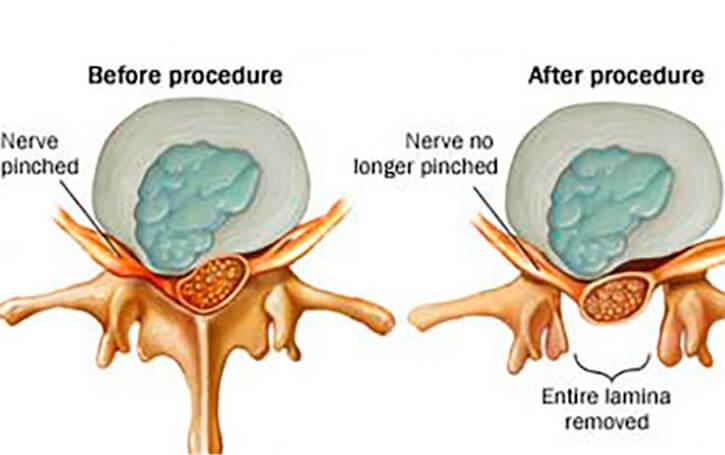Lumbar Laminectomy

Overview
Lumbar laminectomy is a surgical procedure primarily focused on reducing lower back and leg pain caused by spinal stenosis. It involves the removal or trimming of the lamina (part of the vertebrae that covers your spinal cord), aiming to increase the spinal canal’s size to reduce pressure on the nerves. According to the National Institute of Arthritis and Musculoskeletal and Skin Diseases, older adults are more likely to undergo a lumbar laminectomy as spinal stenosis predominantly affects individuals over the age of 50.
Types
There are no specific types of lumbar laminectomy, but the procedure can vary based on the extent of lamina removal. Some patients require full removal, called a conventional or complete laminectomy, while others might only need a partial laminectomy.
Causes
Lumbar laminectomy is primarily performed to treat spinal stenosis, a condition where the spinal canal narrows, compressing the nerves. Predominant causes include age-related changes such as bone overgrowth, thickened ligaments, herniated disks, and spinal injuries.
Symptoms
Lumbar spinal stenosis can cause multiple symptoms, necessitating lumbar laminectomy. Typical symptoms include:
-
- Pain, numbness, or weakness in the legs, calves, or buttocks
-
- Incommodious leg, foot, groin, or hip pain while standing or walking, which usually eases when bending forward or sitting
-
- Loss of bowel or bladder control in severe cases
Diagnosis
Diagnosing spinal stenosis that may require a lumbar laminectomy involves a physical examination, medical history assessment, and imaging tests. These may include X-rays, MRI (Magnetic Resonance Imaging), CT (Computed Tomography) scans, and in some cases, a myelogram (where a contrast dye is injected in the spinal fluid).
Treatment Options
Treatment for spinal stenosis generally starts with non-surgical methods:
-
- Physical therapy, exercises and stretching
-
- Pain relievers, nerve desensitizers, or corticosteroid injections
When conservative treatments fail to provide adequate relief, a lumbar laminectomy is considered. This procedure involves removing the part of the bone or ligaments that are putting pressure on the spinal nerves, often resulting in immediate relief.
Living With Lumbar Laminectomy
Post-lumbar laminectomy, patients generally experience substantial relief from pain and discomfort. However, it’s crucial to:
-
- Continue physical therapy and exercises as directed by the healthcare provider
-
- Take medications as prescribed
-
- Comply with follow-up appointments for progress monitoring
-
- Maintain a healthy lifestyle including an anti-inflammatory diet, proper sleep and weight management
When to Seek Help
Lumbar laminectomy is generally safe; however, like any surgical procedure, potential complications and risks exist. Seek immediate medical attention for:
-
- Inability to control bowel or bladder
-
- Severe ongoing back or leg pain
-
- New weakness in your legs or numbness in your pelvic area
-
- Signs of infection such as redness, swelling, increased pain at the surgical site, or fever
In summarization, a lumbar laminectomy can help reduce pain and improve the quality of life for patients suffering from spinal stenosis. Nonetheless, an adequate understanding of the procedure, adherence to post-op instructions, and regular follow-ups are crucial for complete recovery and long-term success.
